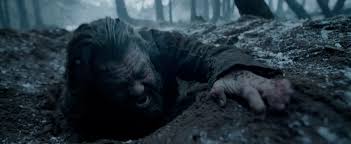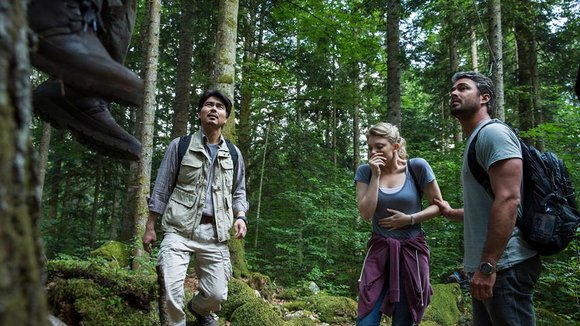
There comes a time in every film critic's career when you just have to admit defeat;
Alejandro González Iñárritu's "The Revenant" certainly conjures up that rare moment
—it is a moment defined by what becomes an overwhelming sense of dubiety, and, well, it is products of this stature that simply force members of my profession to question their analytical acuity. (I'm afraid that viewing this particular picture under a humanistic or psychoanalytical lens will prove to be quite futile. For, Iñárritu's visionary epic is so rich in symbolism and metaphor that it would take extraordinary amounts of mental energy just to put forth an interpretation.)
"The Revenant," a film that chronicles one man's perilous journey to vengeance (that being, Hugh Glass, a real-life frontiersman and nineteenth-century legend), is not only a tour de force that evokes an effortless sense of engagement, but it has to be one of the most aesthetically pleasing pieces ever produced in what is routinely becoming an era dominated by digital filmmaking. (The latest Arri Alexa equipment makes its debut here and once again provides evidence of the digital camera's ability to create a seamless and riveting picture.)
Of course, much of this sublimity can be directly attributed to the use of natural lighting and to the actual time frame of filming. (One would think that these determinations played the biggest part when it comes to the film's visual beauty and breathtaking ambiance.) Iñárritu and cinematographer
Emmanuel Lubezki, a duo that undoubtedly works well together, made the conscious decision to film only at "magic hour"; what a decision it was.
We are given a rather muted color palette and an array of pastel hues that captivate and inspire, and, above all, it calls to mind the efforts of
Terrence Malick (most notably that of
"Days of Heaven"), an American director who is known for indulging in such techniques and a frequent collaborator with Lubezki. (This is not to mention several scenes composed entirely of poetical voice overs and compelling dream sequences, which also reminds us of some of Malick's most poignant moments.) In this regard, borrowing from a fellow auteur may have been Iñárritu's greatest artistic commitment.
What makes "The Revenant" so masterful (besides what I would deem to be a magnificent and competent display of cinematography, which I will peruse in due time) is its complex and unforgiving setting and a handful of performances that never flounder in conviction. The harsh wilderness that accompanies our story here accentuates a number of themes posed by Iñárritu with relative ease as it captures the brutality of nature with a neverending sense of authenticity and as it creates a mood that is surely as tense as it is taut.
In fact, Iñárritu manipulates the perception of this environment in such a way that it essentially becomes a character in its own right, and, structurally speaking, it could arguably be viewed as one of the most indispensable pieces of the puzzle. For, this unforgettable backdrop also becomes a determiner of character, as it pertains to the persona of Hugh Glass, and a symbolic reflection of the truth of human nature. (The latter of which is best encapsulated by the temper of John Fitzgerald
(Tom Hardy), our resident antagonist and a portrait of man's innate callousness.) I have always been
—and always will be
—an advocate for on-location filming, and, in many ways, "The Revenant" demonstrates its usefulness and irreplaceability time after time.
Which brings us to the unforgettable performances of
Leonardo DiCaprio, who steps into the role of Hugh Glass, and Tom Hardy, the aforementioned embodiment of man's brutish nature. Although limited in dialogue, DiCaprio truly gives a gut-wrenching performance, and, truth be told, this is something that I did not expect from an actor who is theoretically past their prime: Is it possible that DiCaprio has not yet hit his ceiling? (However silly that inquiry may appear, it is a question that should be considered.)
This is very much a new kind of role for DiCaprio; I'm sure that he is used to parts brimming with forceful dialogue and explicit conviction. And yet, the role of Glass warranted nothing less than pure physical exhaustion, and, with regard to technique, it required an overabundance of strained facial features and agonizing expressions. In an effort to successfully convey the instinctual aspect of this character, DiCaprio had to basically transform into an individual completely incapacitated by this overpowering sense of savagery. (This exhibition of primitive behavior is best evidenced by DiCaprio's devouring of a raw buffalo liver, which, in many respects, summarizes his dedication entirely.)
As for Hardy, he is cold, calculated and unquestionably authentic in a role that surely demanded such distinctions. Hardy, an actor who continues to rise to stardom in Hollywood, becomes the quintessential villain here, as he ruthlessly commits acts of treason and as he wallows in the darker side of humanity. Although Hardy's dialogue becomes frustratingly inaudible at times (a criticism that he has assuredly heard before), he matches DiCaprio in both spirit and drive, and this only adds to the film's universal appeal.

In any case, however, it is Lubezki's expertise in the field of cinematography, along with Iñárritu's exceptional vision, that really makes "The Revenant" thrive. The methodical execution of the camera's movement not only helps create a mood characterized by its ability to keep one on the edge of their seat, but it really becomes another participant in the action, so to speak. (There are a number of scenes in which the mobile camera essentially mimics the movements of the human apparatus, as it pans and tilts and surveys the surrounding area, and, in a very real way, it increases our involvement considerably.)
Furthermore, there are 360-degree pans, still shots of the moon and nearby flora, and enough extreme close-ups of gushing wounds and incessant gore to make anyone turn their head in revulsion. The incisive decision-making of this captivating collaborative effort even leads to a handful of instances where the lens of the camera becomes a tangible window into this world of beauty and brutality. (This is in reference to a variety of scenes where the lens is blanketed by a character's breath or a splattering of blood, and it is these unprecedented moments, I think, that determine the film's overall worth.)
What is Iñárritu trying to communicate here? At the very least, "The Revenant" is a picture concerned with survival, loss and the perseverance of the human spirit, yet it appears to encompass so much more. (One could even argue that its theme is simply that of texture, as it combines almost every thematic component, with regard to film structure, to produce a seemingly unblemished work of art.) Sure, there are motifs that allude to man's brutish inner self and visual metaphors that can only be interpreted by Iñárritu; however, it would be foolish of me not to designate the film's theme as a philosophical riddle. Considering the overemphasis of the phrase "Revenge is in God's hands now," I believe our riddle may have something to do with the delicate sense of trust between man and divine being.
"The Revenant" is a film that must be viewed more than once; it is the perfect follow-up to Iñárritu's critically acclaimed "Birdman," as this picture verifiably proves that this director has no boundaries. Nevertheless, what we should really be asking ourselves is this: Is Iñárritu really this adroit, or is he just working in a weakened field at this point? Of course, they don't make film directors like they used to, and the cream of the crop are inevitably reaching the twilight of their careers. I tend to believe that "The Revenant" would stand firm even with greater competition, and although some may feel as if this was the apotheosis of Iñárritu's relatively young career, history would tell us that there is more yet to come.

